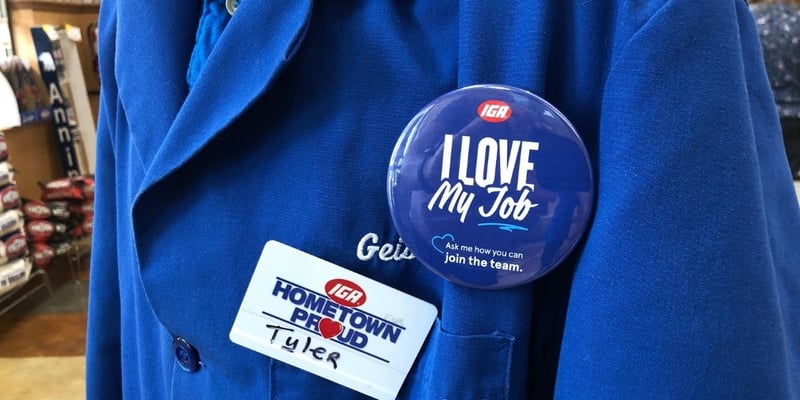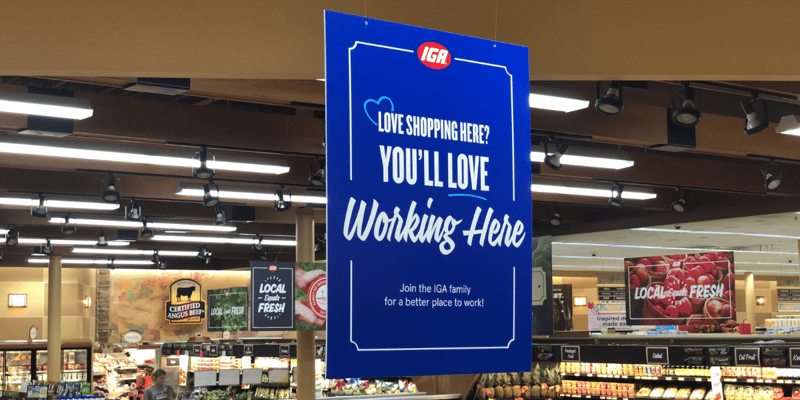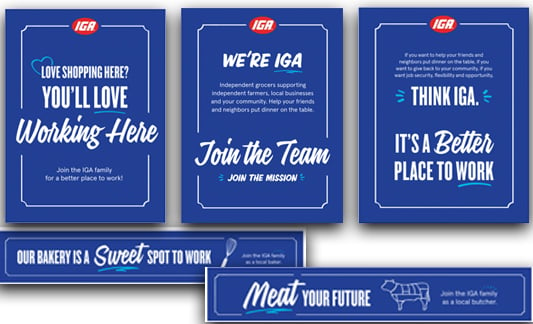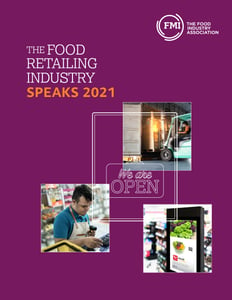Help Isom IGA recover from devasting floods

The grocery industry is facing a severe labor shortage, and it couldn't come at a worse time—consumer demand for groceries is up 50 percent from last year, according to a Food Industry Association (FMI) study. Add a busy holiday season—IRI's latest study shows that Thanksgiving-related grocery categories account for 81 percent of the $2.2 billion sales increase in the four weeks leading up to Thanksgiving—and retailers are scrambling to meet that demand.
The issue isn't new. IGA even commissioned a labor study this summer to learn why people aren't returning to work—limited childcare options, ongoing safety concerns, and increased competition from restaurants are some of the reasons—and those findings still hold up months later in recent studies like FMI's.
So what does entice current employees to stay, especially during the busy holidays when we need as many workers as possible, and what draws in new talent?
"It's not a simple answer, unfortunately," says IGA CEO John Ross, adding, "There's more going on here than money." In fact, 85 percent in the FMI survey said they have increased wages and benefits for full-time employees, but have still seen about a 58 percent turnover rate, which is 40 percent higher than it was in 2019.
"The good news is that there are other tactics that will have as good of an impact or better than money," Ross continues. "The bad news is that you'll have to try a lot of things, and this problem won't go away when COVID does. When there are more jobs than workers, the employer has to work harder to close the deal. All of the data says we have to fix these problems now and come up with smarter strategies to apply now and in the future."
To help you get started, we've gathered hiring and retention tips from our labor study, the IGA Coca-Cola Institute, and IGA retailers. Keep reading to get ideas and use what you think will work for your stores and communities.
How to Retain Employees
"If you can only work on one thing, retention is the way to go," says Ross. "It's cheaper and you get better results if you keep existing employees happy."
These five retention techniques are best practices that will help retailers now and in the future.

1. Regularly Adjust Compensation
"With overall wages rising in the U.S., we may end up paying new employees an unfairly high wage from the perspective of people who have been with us for a long time," says Ross, who encourages retailers to develop a compensation strategy for high-value, loyal employees, for newer employees in need of training, and for new recruits.
Consider proactively bringing all of your employees' earnings to this year's market rates to ensure fair pay. Then develop a regular raise and/or bonus structure for employees new and old. If regular raises aren't financially feasible for your store, think of other incentives you can provide, like paid time off or employee discounts.
2. Provide Ongoing Manager Training
"The most important decision you make at your store is who you select for your management team," says Dr. Paulo Goelzer, president of the IGA Coca-Cola Institute. "Nothing can undo a terrible consequence of designating the wrong person as a supervisor."
Goelzer suggests retailers make leadership training an ongoing process for managers and supervisors. When selecting a new leader, he recommends considering established leadership attributes such as integrity, vision, judgment, passion, courage, empathy, and emotional intelligence.
3. Set Expectations In The Interview
Almost a third of retail workers quit their jobs within the first 90 days of employment, but communication and training can help reduce that number.
Gary and Leo’s IGA Store Owner and 2019 IGA International Retailer of the Year Laura Malisani found that being specific and upfront about job requirements, advancement opportunities, and employee benefits during the application and interviewing process can ensure they stick around for a while.
“Be sure that you’re letting potential employees know exactly what you’re looking for," she says. "Let them know the scheduling process, perks of the job like vacation days, and clarify expectations. We’ve had more people walk off the job because of minor issues—like being asked to put away their phone while they’re working. Ensure employees know upfront what’s expected of them so there are no surprises later.”
4.Offer Better Onboarding
Keep that communication going throughout the onboarding and training process. According to Glassdoor, standardized employee onboarding boosts retention by 82 percent and productivity by more than 70 percent. When you implement a standardized onboarding process, every new hire knows what to expect. Hybrid programs (on-the-job training plus e-learning, for example) produce the best results, according to Goelzer, so use the IGA Coca-Cola Institute, which provides many online training classes for free with your IGA membership.
The programs offer self-paced training on mobile or desktop with student compliance tracking, learning plans, and a built-in library of 250 supermarket-specific courses. Assign a mentor to a new employee for an excellent addition to your extended onboarding process. Mentors provide direction and serve as a sounding board.
5. Listen to Your Team
"When it comes to employee retention, don’t guess what will work," says Goelzer. "Find out directly from your current and former employees!" Employee satisfaction surveys and interviews allow you to ask people exactly what it would take to make them stay, while exit surveys can help you learn exactly why they’re leaving.
How to Attract New Talent
While retaining your existing employees is vital to your operations, you will always need to bring in new team members for holiday hours and to replace retiring or outgoing staff. Here are five best practices to position your store as a great place to work.

1. Offer Tangible Benefits
Besides hourly rate or salary, what other meaningful benefits can you offer employees? Sick pay, paid vacation, and flexible hours are some of the most attractive benefits to job seekers.
"While we can't build a custom schedule for every employee, we can create ways for two-income families to manage work and family needs; we can work around the needs of people like emergency services workers who want and need a second income; and we can grab up seasonal employees like teachers and landscapers when their work has died down. Don't underplay this advantage," Ross advises.
And don't forget to advertise career growth potential. "The key is to make sure prospective employees know you offer skills training and the opportunity for quick leadership advancement," Ross says. "Compared to a lot of other industries, entry level workers have a real opportunity to advance into management quickly with or without a college degree."
2. Incentivize Referrals
Rely on current employees to recruit friends, family, and former colleagues. After all, it's proven to be the fastest, most efficient way to hire, with 82 percent of employers saying employee referrals generate the best ROI (CareerBuilder), and referred candidates found to be 55 percent faster to hire than those sourced through career sites (HR Technologist).
Offer a referral bonus to current employees, which guarantees the referring employee a monetary reward with any successful hire.
3. Tap Non-Traditional Labor Pools
Wright’s Market IGA Store Owner Jimmy Wright has found hiring success by tailoring his hiring message to local seniors. “Many of our older community members are living on Social Security, which leaves them with very little if any extra spending money," Wright explains. "We offer flexible hours so they can work a couple days to stay active, while providing them with some additional income. Ultimately, it’s about finding the right fit for their lifestyle.”
Wright has also found new employees by looking for candidates in non-traditional labor pools. “We have been working with a local rehab facility, with residents who have completed a substance abuse program and are looking to get back on their feet,” says Wright.
And don't forget former restaurant workers. Many don't want to return to an industry that couldn't support them during the worst days of the pandemic, so target your messaging to those with experience in customer service-oriented and food industry jobs.
4. Tell Your Story
"Imagine a message that makes people envision a job they love," Ross advises. "'Want to make a difference in your community?' 'Want to work for a company that gives back and feeds the hungry and helps charities?' Just like we market to shoppers, we're going to market to potential workers."
Ross' example taps into a key element that is striking a chord with the workforce today: working for a company that makes a difference. As a locally owned business, you no doubt have supported your community in a number of ways. Telling that story—whether it’s your support for the local food bank, schools, and community causes, your commitment to sustainability, or your dedication to local, family farmers—shows that your business is a better place to work.
5. Act Quickly
Employers must be prepared to hire quickly—even during the interview itself—due to the competitive nature of hiring right now.
“Make sure whoever is conducting the interview has the authority to hire on the spot. If you find someone you like, don’t risk losing them to someone else,” advises National Retailer Advisory Board (NRAB) Chairman and Geissler's Supermarkets CEO Bob Rybick.
After a long and grueling pandemic, recruitment and retention have become serious challenges, especially for frontline workers in grocery. The strategies shared above can help employers during the holiday season and beyond, as can these labor resources:

IGA's Insights Into Grocery Labor Shortages Webinar
Previous Story
← What does the vaccine mandate mean for you?
Next Story
Gratitude For A Brand That Cares →

No Comments Yet
Let us know what you think